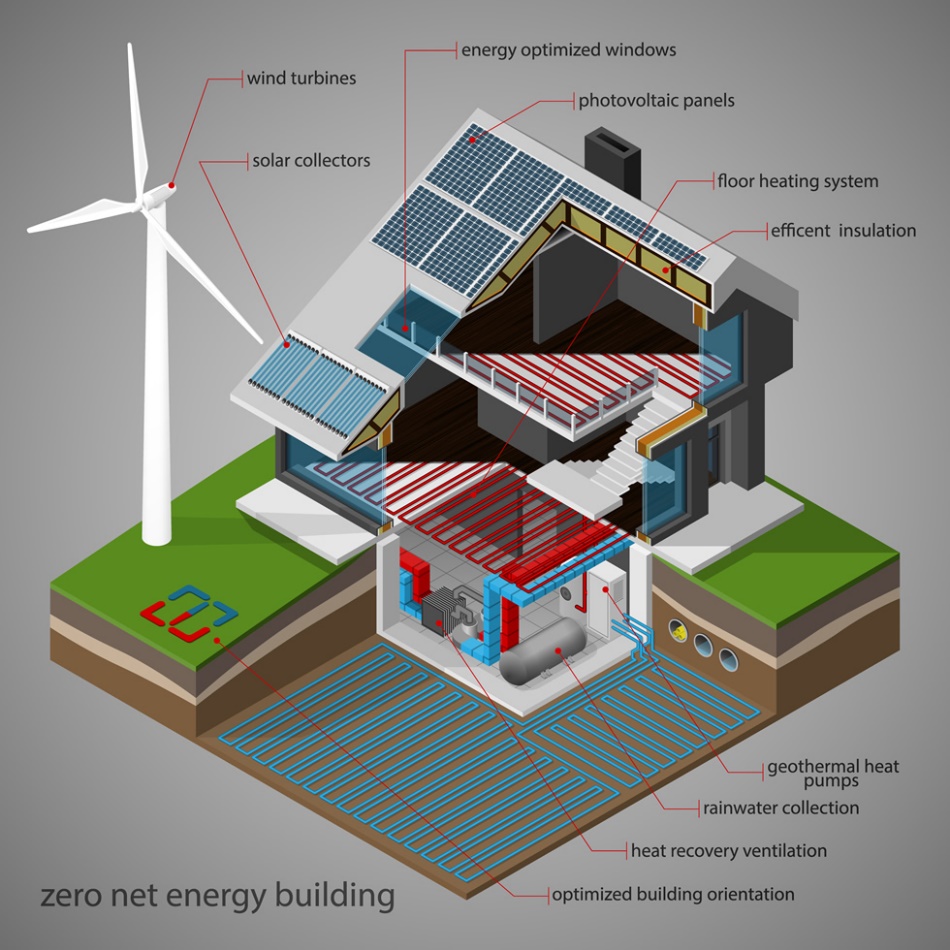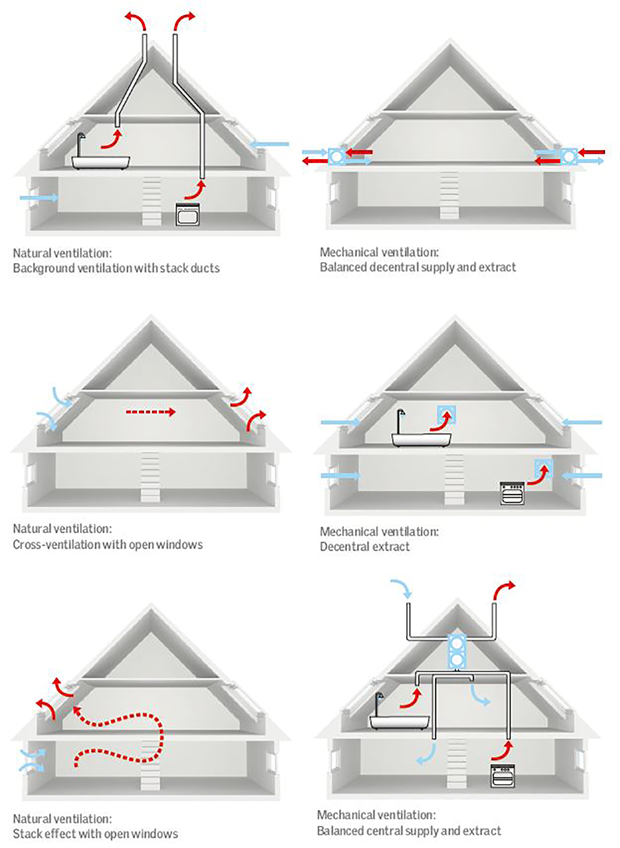Energy neutral buildings
2.1 Introduction
Energy neutral buildings (or zero net energy buildings) are represented by a method of construction and design that has as and end goal to create an energy-efficient building connected to the gird, able to generate its own energy to compensate for the energy demand it creates [5], [6]. This means that the energy neutral buildings have net zero energy consumption, which translated to the fact that the total energy required on a yearly basis is nearly equal to the amount of renewable energy generated on-site or nearby.
Energy neutral buildings efficiently make use of renewable energy generation in order to utilize as much energy as can be produced locally. Even though achieving a complete balance between the energy production and consumption is difficult, this is becoming an increasingly attainable objective that is gaining more and more traction in different parts of the world [7].
Private commercial property owners are becoming increasingly interested in establishing Energy neutral buildings to satisfy their corporate goals, while government are moving toward energy neutral building targets in response to regulatory obligations [6].
Although energy neutral buildings are most frequently associated with commercial buildings, any structure, including residential houses, can be energy neutral, as the principle is scalable and relevant to nearly any type of structure, whether it is a large multi-use facility or a small home [6], [7]. The concept can even be used to complete net-zero towns and institutions.

Source: https://www.energyintime.eu/nearly-zero-energy-standard-2050-eu-half-dream-half-reality/
2.2 Building materials
The creation of building materials and goods requires raw materials and energy in the form of timber, stone, minerals, chemicals and electricity, oil, coal, gas respectively [8]. The manufacturing and transportation of building materials are closely tied cause greenhouse gas emission which, in turn, lead to related environmental consequences [8], [9].
Excessive use of energy-intensive materials and overexploitation can deplete both energy and material resources, as well as cause harm to the environment. Also, meeting the ever-increasing demand for buildings solely with energy-efficient traditional materials and construction methods is not easy.
This is why there is a demand for building solutions that are long-term, environmentally friendly as well as energy-efficient. In order to meet these goals, the most efficient use of available energy resources and raw materials is required [8].
The following concepts represent sustainable alternatives to construction technologies [8]:
- Conservation of energy,
- Minimization of materials that require high energy input,
- Minimization of transportation and increase in the use of local resources and materials,
- Optimal utilization of local skills and decentralized production,
- Inclusion of industrial wastes in the production process of building materials,
- Reuse and recycling of wastes resulted from building,
- Use of renewable energy sources.
Some examples regarding low-carbon alternatives for building materials and technologies can be found below [8], [9]:
- Blended cements,
- Stabilized mud blocks for masonry,
- Compacted fly ash blocks,
- Rammed earth walls,
- Low energy intensity floor and roofing systems,

2.3 Air flow
Buildings with natural ventilation have the potential to save considerable amounts of cooling and fan electrical energy [10]. There are two types of air flow in an energy neutral building: natural ventilation and mechanical ventilation.
Natural ventilation makes use of natural forces such as temperature and wind to facilitate air flow and exchange of air in a building. Mechanical ventilation, on the other hand, makes use of electric fans to direct and control the air flow in a building. Mechanical ventilation is able to provide a constant air flow and ait exchange, regardless of weather conditions, but consumes electrical energy and requires a periodical change of ventilation filters, which are a source of pollution. [10]–[12]
When it comes to air flow and natural ventilation in an energy neutral building, there are two main ventilation concepts [13]:
- Provide adequate indoor air quality without the use of electricity to facilitate air movement,
- Improve daytime air speed and high night ventilation rates for thermal comfort in the summer.
The biggest disadvantage is the recovering winter heat from warm indoor air. However, the key benefit is the ability to achieve high ventilation rates for cooling in the summer without using any electricity, which leads to more energy savings [13].

2.4 Lighting
Natural lighting should be utilized in all energy neutral building designs. After optimizing and maximizing the level of lighting achieved by natural light, task lighting should be added in areas such as kitchen counters, bathrooms, offices etc.
Energy neutral buildings make use of natural light as much as possible by having windows strategically placed in living areas. When it comes to artificial lighting, new and energy-efficient lighting should be used that have the potential to reduce the energy consumption [14].
This makes light emitting diodes (LEDs) the go-to choice, as they are the most efficient and longest lasting light sources available [15], [16]. Another advantage of LEDs – besides the fact that they save energy and reduce lighting costs – is the fact that they also remove mercury exposure that happens when using fluorescent bulbs [14].
The way LEDs create light differs from that of other lighting technologies. In a traditional incandescent lamp, a tungsten filament is heated by electric current until it glows and emits light [17]. In an fluorescent lamp, an electric current drives the gas to generate ultraviolet (UV) radiation, which hits the phosphor coating inside the glass cover and makes it generate visible light [17].
A LED, however, is a semiconductor diode, a device that only permits current to flow in one direction, built from a semiconductor material designed to form a positive-negative (P-N) junction structure [16], [17]. Once a current is applied on the P-N junction, the excess electrons (which are negatively charged) move to the positive side and the excess particles from the positive side (known as “holes”) move to the negative side. At the P-N junction, the holes and electrons interact, which releases energy in the form of light [17].

2.5 Heat pump
Heat pumps are outside units that are part of a heating and cooling system. It is able to both heat and cool a home. A heat pump works by absorbing heat from the cold air outside and transfers it inside the house in the winter, and in the summer by removing heat from inside the house and transferring it outside. Heat pumps run on electricity and – through a refrigerant agent – transmits heat to provide comfort [18]. Also, unlike furnaces, that do not use fossil fuels for heating, making them environmentally friendly and crucial for energy neutral buildings.
Heat pump systems represent a cost-effective way to recover heat from various sources not only in the residential sector, but also in the commercial and industrial sectors [19]. With the increase in energy costs, heat pumps play a key role in energy saving and cost reduction.
Advanced cycle designs for both heat- and work-actuated systems, enhanced cycle components (including working fluid choice), and maximising utilisation in a wider variety of applications have been the focus of recent advancements in heat pump systems [19].
When compared to electric resistance heating such as furnaces and baseboard heaters, today’s heat pump can reduce heating costs up to 50% [20]. In the summer, high-efficiency heat pumps dehumidify better than typical central air conditioners, resulting in lower energy use and more comfort.

Source: https://riverreporter.com/stories/the-heat-pump-basics,41466

 Deutsch
Deutsch Español
Español Italiano
Italiano Nederlands
Nederlands Polski
Polski Română
Română